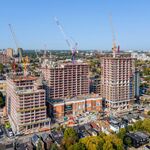Even if that's the case, which I doubt, doesn't that support my idea? If only a small part of the cars are from Toronto, then the millions of people in Toronto must be using something else to get around other than urban expressways. The car-dependent periphery needs the highway, being devoid of rapid transit and the appropriate built form to support it.
However, I think the numbers are more even because we have some highways and some subways. Ours is a sort of hybrid system that doesn't seem to provide either kind of commuter with an ideal network, though the freeway network is incredibly developed relative to the subway system. People from every part of the city use the expressways and highways, but those that live closer to subways are inclined to consider it as an alternative. Even distant suburbanites are increasingly using express local transit to subway stations, as well as GO Transit.




